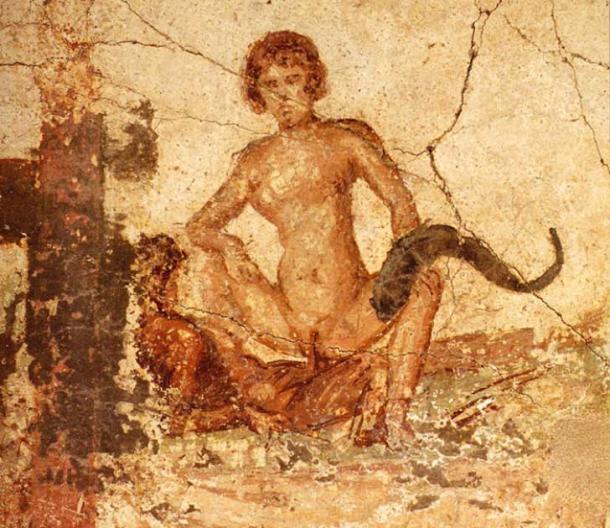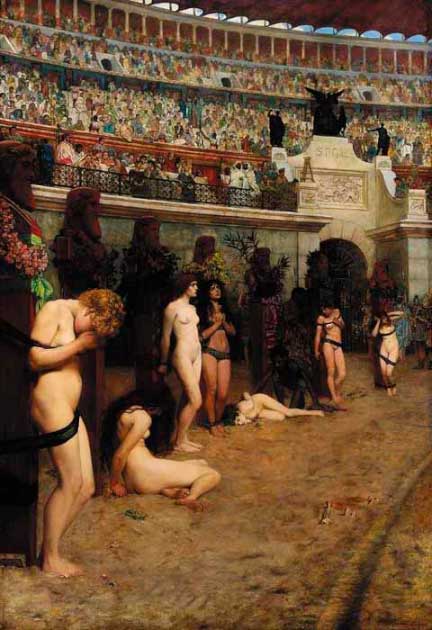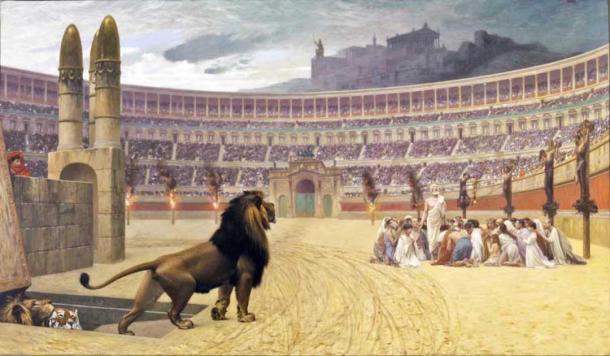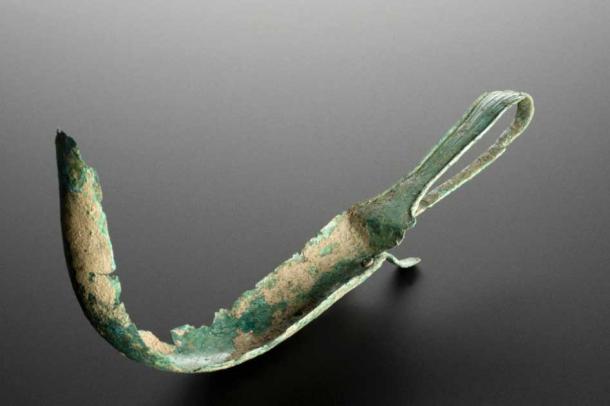
10 Shocking Facts about the Ancient Romans
When studying ancient societies, it isn’t uncommon to experience some culture shock. Even after researching a society for years, you’ll come across something that will stop you straight in your tracks. Few ancient societies have had as big an impact on the modern world as that of the ancient Romans, and evidence of their culture, religion, and laws can still be felt in society today. This doesn't mean however that everything the Romans did made sense. Here are ten shockingly strange facts about the ancient Romans.
1.Wearing Purple Was Banned
It’s pretty much common knowledge at this point that like many societies the Romans were obsessed with class. What many people don’t realize however is just how obsessed the Romans were.
Take, for example, the fact that the majority of free Romans were banned from wearing the color purple. In Roman society, the color purple was associated with glory, power, and royalty. As such the wearing of a purple toga was reserved for only the Emperor and other very high-ranking Romans.
- Mythbusting Ancient Rome: Cruel and Unusual Punishment
- Only the Roman Elite Could Wear Tyrian Purple to Keep the Peasants in Their Place
Why did purple have this reputation? Because it was insanely expensive to produce purple dye. All purple dye was sourced from Phoenicia. To make enough dye for one Toga, ten thousand mollusks had to be crushed. This meant that pound for pound, purple dye was worth roughly the same as gold.
The Romans liked to be able to distinguish a person's class just by looking at them. The ban on purple togas is a prime example of Roman sumptuary law. These were laws brought in that banned lower-class Romans from showing off any wealth they might have. In the Roman class system, you stayed in your place and only the upper classes could flaunt their wealth.

Erotic fresco from the walls of a brothel in ancient Pompeii. (Public domain)
2.Prostitutes Had to Dye Their Hair Blonde
This rule once again has a lot to do with the Roman obsession with class and social standing. The vast majority of natively-born Roman women were dark-haired. Blonde hair was associated with the Gauls and Barbarians.
Prostitution in ancient Roman society was 100% legal and there were no social repercussions for men who used their services. The prostitutes themselves, however, especially the lower-class ones, tended to be looked down upon.
To make sure that no good and honest Roman woman was mistaken for a prostitute a law was brought in that stated prostitutes (many of whom were slaves and as such had no choice anyway) had to dye their hair blonde. The thinking was in this way they would appear more like the barbaric Gauls, rather than the regal Roman ladies.
This law worked, for a little while. Unfortunately for the lawmakers, noble Roman women soon started to envy the sexy blonde look. They began either dying their hair themselves or demanding that the poor prostitutes shave their heads so that blond wigs could be made.
3.Fathers Could Sell Their Sons into Slavery (But Not Too Often)
It is no secret that the Romans made heavy use of slavery. Theirs was an empire built on the backs of their defeated foes. Slaves in Rome had no rights and lived miserable lives. For the most part, Roman citizens were free from the dangers of slavery, unless they broke the law.
Yet there was one quite peculiar exception. Roman fathers could sell (or more like rent out) their sons into slavery, but it was only temporary. The father and prospective buyer would come to an agreement as to the price and duration of the son's slavery. When the time was up, the buyer was expected to bring the son back in roughly the same condition he had received him in.
Like most things in Roman society, the father could only do this in moderation. He could sell the same son twice and everything was fine. Nevertheless, if he sold the son a third time he was deemed to be an unfit father. Any son who was sold by his father three times was legally emancipated from his greedy parents (but only after he’d finished his third stint as a slave).
The “3 sales rule” applied to each child, however. That meant that if a father wanted to keep making money from his children all he needed to do was keep making more of them.

The Slave Market, by Gustave Boulanger. (Public domain)
4.Originally Father’s Were Legally Allowed to Kill Their Families
Ancient Rome was always a patriarchal society, but in the early days the Romans really took it to extremes. In early Rome, the members of a man’s family were essentially his possessions. He could do with them what he wished, which explains why he could sell his sons into slavery.
It was up to the father to choose how he punished his children. If he felt that his children deserved to die, then he could kill his children without legal repercussions. Even leaving home didn’t mean his children were safe. Even after being married off and leaving the nest, a daughter could still be murdered by her father. Sons were never safe either. They only became truly independent after being sold three times (not exactly ideal) or after their father had died.
Eventually, these rules were relaxed. By the first century BC, a mans right to murder his family had been abolished, for the most part. But, if a son was convicted of a crime (therefore tarnishing his family name) a father was still allowed to kill him.
5.Rome’s Ultimate Punishment
Being killed by your father wasn’t the worst way to go. The Romans had lots of inventive ways to kill criminals and prisoners. They could be beheaded, thrown from a height, or forced to take part in gladiatorial games and spectacles.
The worst form of execution was saved for those who committed the ultimate crime, patricide. Anyone found guilty of patricide was first blindfolded due to the fact that they were seen as no longer worthy of being in the light. They were then marched out of town and directly to the nearest large body of water.
Once there they were beaten with rods to within an inch of their lives. They were then bound and thrown into a large (but not too large) leather sack along with a snake, dog, ape, and rooster. The whole posse was then thrown into the water where they either drowned or were killed by the thrashing animals.

The ancient Romans invented some curious and cruel forms of execution, including damnatio ad bestias, whereby criminals were tied to a pole for savage animals to kill. (Public domain)
6.They Had Confusing Rules Regarding Adultery
Unsurprisingly, the Romans had conflicting rules depending on who was caught cheating, the wife or the husband. Also unsurprisingly, husbands were pretty much free to do what they liked. Husbands could have mistresses and sleep with prostitutes and no one would bat an eyelid. It only became an issue if the husband was deemed to be overindulging.
For the wife, it was a very different story. When a husband found his wife in the throes of passion with another man he was obligated to lock the two lovers in the room. The clock then began ticking and he had 20 hours to gather as many people as he could to act as witnesses.
Once he had had his witnesses, he had a further three days to gather his evidence. He needed to know how long the affair had been going on, where it had occurred, and who the lover was, as well as any other pertinent details he could muster.
Once he had his facts in order, the husband had to divorce his wife. The Romans weren’t big on forgiveness and if the husband failed to divorce his wife he faced being charged with pimping his spouse out.
If the husband really wanted revenge he could kill his wife's lover as long as he was a slave or prostitute (neither of whom enjoyed any rights in Roman society). If the lover was a citizen, things became trickier.
The husband then had to go to his father-in-law and get him involved. Fathers in Rome had the right to kill their daughter's lovers. If the father wished it, the lover was dead, no matter his social station. There was also a chance the father would decide to kill his daughter while he was at it, saving the husband the trouble of a divorce.

Christian Marturs' Last Prayer by Jean-Léon Gérôme. (Public domain)
7.They Thought Christianity Was a Cannibalistic Blood Cult
While it certainly wasn’t great being invaded by the Romans, as conquerors go they weren’t all bad. For example, they tended to leave indigenous people’s belief systems pretty much well alone. At most the Romans had a habit of assimilating other people's religions into their own. Hence why the Roman and Greek pantheons are so similar.
So, why did the Romans have such an issue with the Jews and early Christians for so long? Well, part (but not the whole) of the reason is simply that Jewish and Christian practices grossed the Romans out.
The Romans really didn’t approve of the Jewish practice of circumcision, seeing it as a cruel form of genital mutilation. The Romans did some pretty horrendous deeds in the name of their gods but apparently, that little bit of skin at the tip of the penis was a step too far, even for them.
Christians on the other hand were first seen as cannibalistic blood cultists. The Romans didn’t get the metaphor and took the “Flesh of Christ” and “Blood of Christ” parts of the holy communion a little too seriously.
8.Gladiator Body Parts for Medicinal Use
Ironically this Roman squeamishness didn’t extend to gladiator body parts. Roman physicians believed consuming gladiator body parts could help treat various ailments. Apparently, their blood and livers were especially good at treating epilepsy. When the gladiator games were banned after 400 AD the Romans began using the blood of executed criminals instead.
If that wasn’t disgusting enough, this obsession with consuming gladiator parts extended into Roman beauty treatments and even into the bedroom. Gladiators’ dead skin cells (scraped up from their baths) were used in face creams and as aphrodisiacs.

A heavily corroded Roman bronze Strigil housed in the Science Museum in London. A strigil was a Roman tool used to scrape off excess oil, skin, dirt and sweat. Gladiators would sell containers of their sweaty skin scrapings. (Wellcome Collection / CC BY 4.0)
9.Urine Was a Valuable Commodity
The Romans made heavy use of public toilets. They weren’t just places to relieve oneself, but also important social hubs. Of course, these busy public toilets produced a lot of waste, so the Romans had to get pretty inventive in getting rid of it.
The Romans were great engineers. In Rome, most of the citizenry’s sewage ended up in the Cloaca Maxima (one of the world’s earliest sewage systems). From here urine was collected and, thanks to its ammonia content, was sold as a chemical used in laundry and tanning leather. Outside of Rome itself fullones (Roman dry cleaners) would visit the toilets and collect the urine themselves.
Urine became such a big business that Emperor Vespasian (69-79 AD) began taxing it. When his son, Titus, complained of the disgusting way his father was making his coin, Vespasian told his son to smell a gold coin. He then asked him if it stank, and when his son replied in the negative the Emperor replied “Yet it comes from Urine.”
10.Roman Public Toilets Were Disturbing
For the most part, the Romans have been remembered as clean people and this was largely true. This doesn’t mean that Roman public toilets would pass muster today though.
Rome was home to over 140 communal public toilets. These weren’t private spaces but places where people socialized while they did their business. As mentioned earlier most of these public toilets were connected by impressive sewage systems that it would take later societies centuries to be able to rival.
The good news stops there. Archaeologists have found plenty of evidence to suggest these public toilets were biohazards waiting to happen. Evidence suggests these toilets were pretty much never cleaned. Archaeological evidence shows they were crawling with parasites like roundworms, fleas, lice, and of course, cockroaches.
- Money Does Not Stink: The Urine Tax of Ancient Rome
- No Toilet Paper! Do Any of these Ancient Methods Work for You?
If this wasn’t bad enough, these toilets pre-dated toilet paper by a couple of millennia. Each public toilet housed only one solitary sponge on a stick, known as a tersorium. This was used to “wipe” after defecating. This also never got cleaned.
As if this wasn’t all bad enough, animals like rats and snakes lived in the sewage system. There are records of people who spent too long on the toilet being bitten where no one wants to be bitten. The toilets also produced large amounts of methane. This had a nasty habit of building up beneath the toilets until it finally ignited and became startlingly explosive.
Things were so bad that spells designed for warding off demons have been found etched into the walls of public toilets. People went so far as to bring statues of Fortuna, the Roman Goddess of luck, with them when they needed the toilet.

A replica tersorium, or a sponge on a stick, was used to wipe after defecating in an ancient Roman public toilet. (D. Herdemerten / CC BY 3.0)
Facts About the Romans
The modern world owes a lot to the ancient Romans. In many, many ways they were incredibly advanced for their time. Yet for centuries historians overly romanticized the Roman period and its flaws were often ignored.
When looking at their rules and laws we can see that in many ways the Romans were startlingly brutal. Civil rights, unless you were born into the right family, were almost non-existent and slaves lived a hellish existence. Ancient Rome was nowhere near as liberal as some historians once had us believe.
But we must remember that social evolution is often a case of one foot forwards, two steps back. A Roman transported to our time would likely find some of our practices just as disturbing. Likewise, a time traveler from the future would likely be appalled at what they found. So, we must always try to learn from history without judging too harshly
Top image: From the Old Colosseum, by Valdemar Irminger. Source: Public domain
References
Beck. J. 2016. “Roman Plumbing: Overrated” in The Atlantic. Available at: https://www.theatlantic.com/health/archive/2016/01/ancient-roman-toilets-gross/423072/
Bradley. K. 1991. “A Roman Family” in Di scovering the Roman Family: Studies in Roman Social History. Oxford University Press.
Joshi. N. 2021. “Prostitution in Ancient Rome” in History Ten. Available at: https://historyten.com/roman/ancient-rome-prostitution/
Liebs. D. 2008. “Roman Vulgar Law in Late Antiquity” in Freiburg University. Available at: https://freidok.uni-freiburg.de/fedora/objects/freidok:6857/datastreams/FILE1/content
Malik.S., Davenport. C. 2018. “Mythbusting Ancient Rome: cruel and unusual punishment” in The Conversation. Available at: https://theconversation.com/mythbusting-ancient-rome-cruel-and-unusual-punishment-87939
















Comments
The question is, were the Romans Gentiles or Semites? History tells of the Semites and their white slaves (concubines and eunuchs), and the Romans had a similar culture in that regard. Hard to imagine Gentiles, or Germanics, doing all that inhumane stuff to themselves. And many Romans were black-headed (black-haired), and of course the myth of Romulus and Remus being suckled by a black dog. So a genetic study (of ancient graves) is definitely in order to clarify the distinctions? Nowadays, they can even tell hair color from the DNA, we'd learn something there too.
Nobody gets paid to tell the truth.
Please may I see the evidence, clear and concise of all these facts about Roman society and perhaps a balanced comparison to our current society.
Watch carefully and you will see none.
Was Pagan Rome convinced that Christians drank blood? Probably, for propaganda was a Roman elite staple, just as it is a current elite one.
That said, some prominent Christians do drink blood in Rome today and elsewhere. However, their Christianity is but a pretence and a cover for a much darker faith. In that sense our improvement from ancient Roman barbarism is mostly a case of modern society kidding itself. We like to think we're better and cleverer, but the truth is humanity doesn't change that much and serious sin can be a whole lot of fun for those prepared to put their morality in the deep freeze. Once that is done, anything goes.
Going applies also to those who don't want to face the truth, for they tend to run and hide in a fantasy world wardrobe where everything is okay. They are legion, if not legionnaires. They couldn't battle their way out of the proverbial wet paper bag. Meanwhile, those that can, such as the military, follow into battle unquestioningly whatever orders they're given, which isn't much better. That applies now just as it did then.
Homo 'sapiens' is such an inappropriate name. 'Timidus' would have been a better choice of a taxonomic starting point. Grand civilisations are often built on a base of cowardice. All those Romans cheering the death of martyrs were the cowards that built Rome.
The Romans are considered a very advanced society for their time, or any time. Some of your 10 Roman “Shocking” facts are indeed shocking to us now, some of them are mudane and some of them are almost unbelievable.
We must remember to never judge an ancient society by our current ideals. I’m sure they would find some of our “facts” shocking and disgusting.